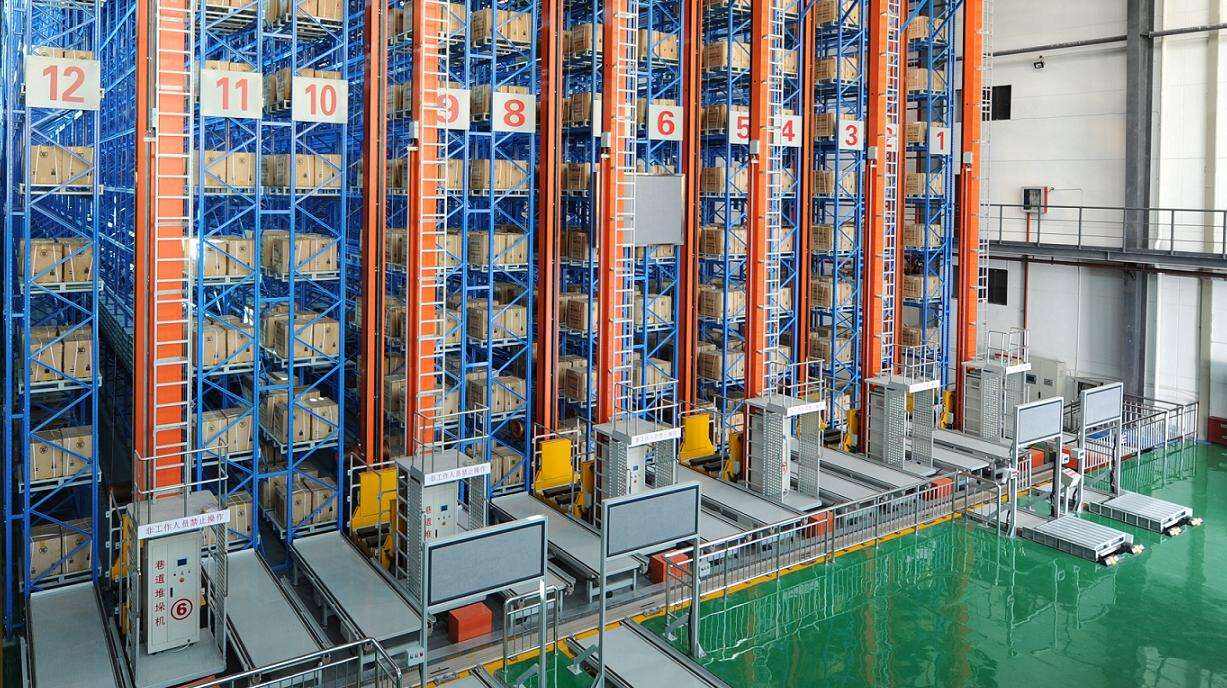Maximizing Space Utilization with Automated Racking Systems in Cold Storage
Automated Storage and Retrieval Systems (AS/RS) revolutionize cold storage operations by optimizing every cubic meter of available space. These systems address the critical challenge of balancing storage density with operational efficiency in temperature-controlled environments.
Leveraging vertical space: How AS/RS enables high-density storage in cold rooms
AS/RS systems today can reach storage heights over 40 meters tall, which is almost twice what we see in old fashioned manual setups, all while keeping temperatures tightly controlled throughout. The ability to stack so high really matters for cold storage operations located in cities where buying extra ground space just isn't feasible because of sky high property prices. These systems use special materials that resist frost damage, so they stay strong and reliable even when temps drop below freezing point at around minus 30 degrees Celsius. This means businesses can make better use of their warehouse ceilings without worrying about structural failures or safety issues during long term cold storage operations.
Narrow-aisle design reduces footprint and increases storage capacity
By reducing aisle widths to as little as 1.6 meters—compared to 3.5 meters in conventional warehouses—AS/RS configurations increase pallet positions by 60–80% within the same floor area. This spatial efficiency directly reduces refrigeration demands, as fewer cubic meters require climate control, lowering both energy use and operating costs.
Case study: 40% improvement in floor space utilization using unit load AS/RS in a European frozen food center
One major frozen food distributor in Europe saw their storage capacity jump by nearly half when they installed this massive 32 meter tall automated storage system. The new shuttle based setup basically cut down on all the walking around inside their super cold warehouse that stays at minus 25 degrees Celsius most of the time. With so much less human activity going back and forth, the doors stayed closed more often which actually saved them almost a third on their energy bills. What's really impressive is how this single change let them store an extra 15 thousand pallets right where they were already operating. No need to build anything new or spend money on expanding facilities. This kind of efficiency just wasn't possible before with those old fashioned cold storage methods companies used to rely on.
Boosting Operational Efficiency Through Shuttle-Based and Mini Load AS/RS

Faster inventory turnover with shuttle-based AS/RS in sub-zero environments
Shuttle based automated storage and retrieval systems really speed things up when it comes to rotating stock in freezing environments where people just can't keep up with the work anymore. These systems have special thermal seals and smart routing algorithms that keep everything moving smoothly even at minus 20 degrees Celsius. This means warehouses can stay open around the clock without putting staff members through the misery of working in such brutal cold. According to research published last year in the field of cold chain logistics, companies that switched to these shuttle systems saw their on time delivery rate jump from about 76% in traditional warehouses to nearly perfect at 98% during busy periods. Makes sense why so many distributors are making the switch these days.
Mini load AS/RS optimizes handling of small, high-turnover items in cold storage
Mini load systems make it much easier to handle those small packages of frozen items and pharmaceutical samples without damaging them. These systems come with special storage trays that have built-in temperature sensors, letting staff check product quality as they work. The Cold Chain Federation reported last year that such setups cut down on manual handling by around 40 percent. For vaccines specifically, keeping temperatures stable matters a lot. Even if the temperature goes up just 2 degrees Celsius, whole batches could be ruined, which means these systems aren't just convenient they're actually critical for meeting FDA requirements in proper vaccine storage.
Pallet shuttles cut retrieval times by up to 60%
These bidirectional shuttle carts can handle storage and retrieval of pallets at the same time across different temperature areas, cutting down retrieval times significantly. What used to take around 8 minutes now happens in just 3 minutes even when temps drop to minus 25 degrees Celsius. Real world testing has confirmed what many suspected already these systems boost warehouse efficiency quite a bit. And there's another benefit too. The energy recovery features grab back about 15 percent of the energy lost during braking, which then gets used to keep those onboard sensors running. Makes sense for companies trying to cut costs while still meeting their green targets.
Emerging trend: Integration of autonomous mobile robots (AMRs) for enhanced flexibility
Cold storage facilities are increasingly mixing fixed automated storage and retrieval systems (AS/RS) with special anti-fog autonomous mobile robots (AMRs) that can handle shifting inventory needs. These robots actually work pretty well in those damp, freezing areas where regular AGVs tend to fail completely. The ones who tried this combo first saw their inventory setup times drop by around 30% when dealing with seasonal products, according to what they've been saying about their experiences with these mixed system approaches. Many warehouses find this combination especially helpful during peak seasons when product types change rapidly.
Enhancing Worker Safety and Reducing Human Exposure in Cold Environments
Minimizing labor in extreme cold lowers health risks and fatigue-related incidents
Automated racking systems handle 89% of material movements in modern cold rooms, drastically reducing worker exposure to sub-zero temperatures. Studies show such facilities experience 72% fewer frostbite incidents than manually operated warehouses. By eliminating prolonged exposure during retrieval tasks, these systems align with CDC guidelines on cold stress prevention.
Automation reduces on-site personnel needs, improving overall safety compliance
With AS/RS, cold storage facilities operate safely with 40–60% fewer workers in hazardous zones. This reduction addresses OSHA concerns about slip/fall risks, which account for 34% of warehouse injuries in refrigerated environments (BLS 2023). Advanced sensors prevent equipment collisions 98% more effectively than manual forklift operations, further enhancing safety.
Balancing automation adoption with workforce impact: Addressing job displacement concerns
Forward-thinking operators are reskilling 65% of affected workers into automation supervisory roles. While automation initially reduces manual labor needs, it creates 23% more high-skilled positions in system maintenance and data analysis within five years, according to Material Handling Institute projections (2024).
Improving Energy Efficiency in Cold Rooms Through Automated Pallet Movement
Reduced Door Open Time From Automated Systems Cuts Refrigeration Loss
Automated racking systems reduce cold room entry frequency by 72% compared to manual operations. Coordinated pallet movement sequences cut average door open durations from 120 seconds to just 34 seconds, minimizing warm air infiltration and preserving thermal integrity—key factors in reducing energy waste.
Stable Thermal Environment Maintained Through Precise AS/RS Integration
Automated systems maintain consistent ±0.5°C temperature uniformity through predictive load positioning, real-time thermal mapping, and adaptive airflow management. This precision reduces compressor cycling frequency by 40% in frozen storage environments (-25°C), directly lowering energy consumption.
Reported Energy Savings of Up to 30% Post-AS/RS Implementation
2024 cold storage energy benchmarks show significant gains from AS/RS adoption:
| Metric | Manual System | AS/RS Implementation | Improvement |
|---|---|---|---|
| kWh/pallet/day | 8.7 | 6.1 | 30% reduction |
| Peak load demand | 4.2 MW | 3.1 MW | 26% decrease |
These improvements stem from synchronized automation that optimizes both spatial utilization and thermal regulation.
Scalability and Long-Term Flexibility of Unit Load AS/RS in Cold Storage
Modular expansion capabilities allow growth without operational disruption
Today's automated storage and retrieval systems come with modular designs that make it possible to expand vertically past 100 feet or scale out horizontally while keeping frozen supply chains running smoothly. Many companies now rely on cloud based management software which allows warehouse managers to add new storage areas or install robotic parts without major disruptions. The ability to grow operations this way matters a lot to businesses in the cold chain sector. According to recent research from Material Handling Institute published last year, around two thirds of companies expanding their facilities consider this kind of scalability absolutely essential for their growth plans.
Adapting automated racking systems to seasonal and demand fluctuations
Mobile aisle cranes bring real flexibility to warehouse operations. A single retrieval system can actually handle several temperature controlled aisles at once during busy times. Some studies indicate that these adaptable systems cut down on setup time by about 40 percent compared to traditional fixed aisle setups when products need rearranging. For businesses dealing with seasonal demand swings, automated storage and retrieval systems (AS/RS) are particularly handy. They let companies shrink or grow their active storage space as needed while still keeping energy costs under control even when inventory levels fluctuate by plus or minus 35%. This kind of adaptability makes all the difference for operations that face unpredictable market conditions throughout the year.
FAQ
What are Automated Storage and Retrieval Systems (AS/RS)?
AS/RS are advanced systems that enhance cold storage operations by optimizing space, increasing efficiency, and providing precise temperature control. They allow for high-density storage by utilizing vertical spaces and narrow aisles, thereby improving operational efficiency and reducing energy consumption.
How do shuttle-based AS/RS improve inventory turnover?
Shuttle-based AS/RS facilitate faster inventory rotation by utilizing smart routing algorithms and thermal seals, allowing for continuous operation in sub-zero environments. This leads to improved delivery times and operational efficiency.
Can AS/RS systems reduce energy costs in cold storage?
Yes, AS/RS systems can significantly reduce energy costs by lowering refrigeration demand, maintaining stable thermal environments, and reducing door open time, which minimizes warm air infiltration.
Are automated racking systems safe for workers?
Automated racking systems enhance worker safety by reducing manual intervention and exposure to harsh environments, minimizing the risk of frostbite and fatigue-related incidents. They also improve compliance with safety regulations.
How do AS/RS systems handle demand fluctuations?
AS/RS systems offer modular and flexible solutions that allow for easy scalability and adaptation to seasonal or fluctuating demands without disrupting operations, thus ensuring continual efficiency.
Table of Contents
- Maximizing Space Utilization with Automated Racking Systems in Cold Storage
- Boosting Operational Efficiency Through Shuttle-Based and Mini Load AS/RS
- Enhancing Worker Safety and Reducing Human Exposure in Cold Environments
- Improving Energy Efficiency in Cold Rooms Through Automated Pallet Movement
- Scalability and Long-Term Flexibility of Unit Load AS/RS in Cold Storage
- FAQ

